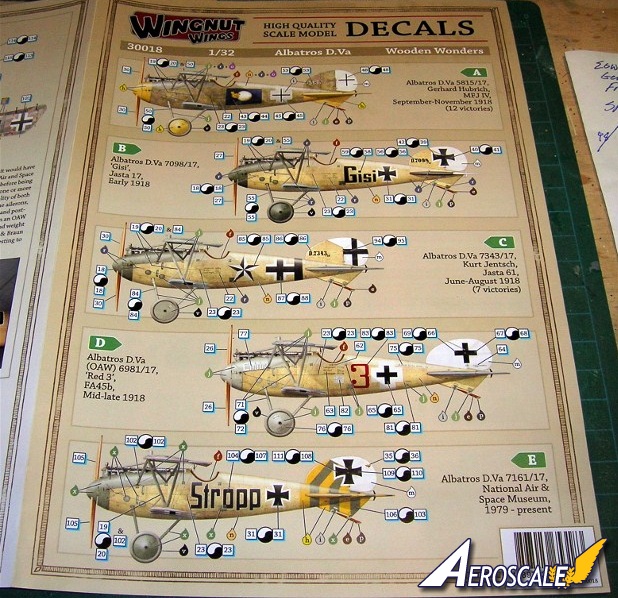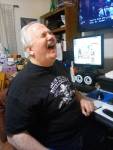GVW continues.
"For those who don't have access to them, here are some of the descriptions and stories about "STROPP" that Stephen and others have referenced:
In “Cross & Cockade” (US) Volume 4, No. 2, 1093, renowned aviation historian Peter M. Bowers wrote an article on STROPP. Here are the relevant passages:
“I had made extensive notes on this machine during the 1930’s, including tracings and dimensions of the insignia (thanks to my Grandmother being a good friend of the director, which made it possible to visit after hours, set up ladders, etc.) Unfortunately, all these notes were lost when my home was burned in 1939, so all I’m going on is an enthusiast’s memory of some twenty-five years.
“I first saw the ship, hanging up in the “War Room” (of the DeYoung Museum) in 1930, but I didn’t know what it was at the time. In those days the old Flying Aces magazine was coming out with a two-page spread of very simple line sketches and brief descriptions of WWI ships by C.B. Colby. When the Halberstadt CL.II appeared in this series, I thought that’s what the Museum ship was because of a cut-out behind the pilot’s cockpit that made it look like a two-seater. Such obvious differences as a round fuselage for an Albatros versus a flat-sider for a Halberstadt (not too evident from the Flying Aces drawing) didn’t sink into a 12-year-old mind. Detailed identification was further complicated by the fact that the rudder and ailerons were not installed, nor were the wing struts. The only identification was a framed placard proclaiming it to be a captured German aeroplane and that it was a gift of the French government.
“I remember the colors and markings very well. The fuselage was natural varnished wood, blending to a yellow stabilizer with black diagonal stripes. I could not tell if this pattern was repeated on the top side because the dust was too thick to see through when I was up on the ladder. Whether the darker shade on top of the fuselage was paint or accumulated grime, I don’t know. The word “STROPP” in lower-case German letters, black with a white border, appeared on one side of the fuselage; and if I recall, the word “SCHENCK” was on the other side (sic). White-bordered Formée Crosses were on the fuselage and part of one was on each fin.
“I never did see the coloring on the top of the upper wing, but the bottom side was painted a shiny, dark grey; obvious (even as a kid) as a restoration. The lower wing was covered with a lozenge camouflage fabric. I gave up trying to trace that pattern by holding tracing paper up against the bottom surface. The bottom side of the wing carried straight sided open-end crosses painted over the Formée type. Since it wasn’t logical to find such a mixing of national markings on a combat type, I concluded much later that this particular Albatros was actually made up of parts of two different machines captured at different times.
“Sometime in the middle 1930’s, the WPA did a restoration job on the airplane, in spite of recent reports to the contrary. By this time I was considerably more savvy on the subject of WWI airplanes and found plenty to scream about. The hole behind the cockpit was neatly patched, so now we will never know whether it was actually a second cockpit, or not. I didn’t look into it in the earlier “ladder” days for evidence of a seat or other signs of occupancy. New dummy struts were made, of wood instead of steel tubing, and very fat and out of proportion. Worse, a fourth center section strut was added to each side. Rudder and ailerons were still off, I could never get close enough to check other details as the “War Room” was always closed or alterations during my rare post-restoration visits, and I had to peer through locked grills from an adjacent room.
“When the “War Room” was finally re-opened, it had been so altered that the ceiling was no longer high enough to hang the bird safely out of reach. With the grubby paws of little monsters getting at it, the museum retired it from storage, where it was when last I came to see it around 1940…Colonel Kimbrough S. Brown reports seeing it in the Smithsonian’s warehouse and that the rudder and ailerons are installed with it.”
__________________________________________________ ___________
In Volume 5 No. 1 of Cross & Cockade, Volume 5 No.1, 1964, the journal published a letter from one Frank J. Macintosh of San Francisco, who also supplied the only known photo of the Albatros hanging from the ceiling of the DeYoung Museum. Macintosh wrote:
“My enthusiasm for the Journal compels me to take umbrage with the article by Peter Bowers as he, relying on childhood memories, chose to describe a particular aircraft with which I am better acquainted.
“The Albatros D.Va in the DeYoung Museum (San Francisco) was original, and I can assure you that no second seat was evident. There was a hole prior to 1936, underneath and behind the cockpit cause by the curious and/or looters.
“The word, or name, ‘Stropp’ appeared on both sides of the fuselage. Only the right aileron was missing. The rudder was looted crudely, being sawed off, leaving the rudder post attached. All metal cowlings were gone; also missing were the shock-cords and axle fairing.
“The renovation done in 1936 amounted mainly to the struts, as mentioned by Bowers, the basketball-sized hole underneath being patched with fabric, and some plywood being applied around the nose. As for coloring; the wings were as Pete described, the fuselage all-varnish with only the ‘Stropp’ business on the sides. The stabilizer-elevator had the diagonal black-yellow stripes which originated on top, with one vertical stripe on the fin which obliterated the serial number.
"I last saw this aircraft in October 1943, and sat in the cockpit. Little did I realize it was to be sold at public auction for $500 several years later."



















